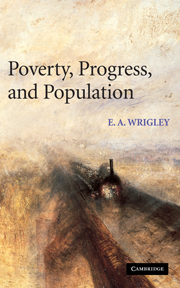Book contents
- Frontmatter
- Contents
- List of figures
- List of tables
- Acknowledgements
- Introduction
- PART I The wellsprings of growth
- 1 The quest for the industrial revolution
- 2 The divergence of England: the growth of the English economy in the seventeenth and eighteenth centuries
- 3 Two kinds of capitalism, two kinds of growth
- 4 Men on the land and men in the countryside: employment in agriculture in early nineteenth-century England
- 5 The occupational structure of England in the mid-nineteenth century
- 6 Corn and crisis: Malthus on the high price of provisions
- 7 Why poverty was inevitable in traditional societies
- 8 Malthus on the prospects for the labouring poor
- PART II Town and country
- PART III The numbers game
- Bibliography
- Index
5 - The occupational structure of England in the mid-nineteenth century
Published online by Cambridge University Press: 23 December 2009
- Frontmatter
- Contents
- List of figures
- List of tables
- Acknowledgements
- Introduction
- PART I The wellsprings of growth
- 1 The quest for the industrial revolution
- 2 The divergence of England: the growth of the English economy in the seventeenth and eighteenth centuries
- 3 Two kinds of capitalism, two kinds of growth
- 4 Men on the land and men in the countryside: employment in agriculture in early nineteenth-century England
- 5 The occupational structure of England in the mid-nineteenth century
- 6 Corn and crisis: Malthus on the high price of provisions
- 7 Why poverty was inevitable in traditional societies
- 8 Malthus on the prospects for the labouring poor
- PART II Town and country
- PART III The numbers game
- Bibliography
- Index
Summary
This essay represents an early step on what may prove a long road. That English society and economy changed greatly in the early modern period is evident, and that towards the end of the period it had become very different from its continental neighbours is also abundantly clear. One aspect of change which, given suitable sources, is in principle quantifiable, was that reflected in the occupational structure of the country. The character of a country's economy at a point in time and the nature of any changes taking place over time are necessarily reflected in its occupational structure. Employment is shaped by aggregate demand. The structure of aggregate demand in turn is largely determined by the income levels of consumers. Demand for the basic necessities will always predominate where most of a population lives miserably, and it is not therefore surprising that agriculture provides employment for three-quarters or more of the labour force where poverty is deep and widespread. Food always takes priority over other requirements and among the poorer sections of society often claimed the bulk of their household budgets. But the income elasticity of demand for necessities is normally less than unity and therefore if real incomes rise there is a disproportionately rapid rise in the demand for other goods and services and a parallel rise in the percentage of the workforce which is employed in producing them. The secondary and tertiary sectors expand at the expense of primary employment, at least when expressed as percentages of the labour force rather than in absolute numbers.
- Type
- Chapter
- Information
- Poverty, Progress, and Population , pp. 129 - 203Publisher: Cambridge University PressPrint publication year: 2004
- 2
- Cited by



